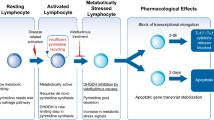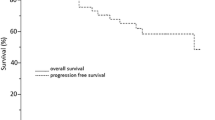Abstract
P-glycoprotein (P-gp) on activated lymphocytes is an adenosine triphosphate (ATP)-binding cassette transporter that causes drug resistance by exclusion of intracellular drugs in patients with active rheumatoid arthritis (RA). However, infliximab with methotrexate (MTX) can overcome P-gp-mediated drug resistance. We encounter patients who cannot continue infliximab or MTX. Here we tested how etanercept affected P-gp-mediated drug resistance in such intractable RA patients. Peripheral lymphocytes of 11 RA patients (3 switched from infliximab and 8 who could not be treated with MTX) were analyzed for P-gp expression by flow cytometry and for drug exclusion using radioisotope-labeled dexamethasone. Activated lymphocytes of RA patients overexpressed P-gp and coexpressed CD69. Incubation of these lymphocytes with dexamethasone in vitro reduced intracellular dexamethasone levels. Two-week etanercept therapy significantly reduced P-gp expression and eliminated such P-gp- and CD69-high-expressing subgroup. The reduction in P-gp resulted in recovery of intracellular dexamethasone levels in lymphocytes and improvement of disease activity, thus allowing tapering of corticosteroids. None of the patients experienced any severe adverse effects. Etanercept is useful for overcoming P-gp-mediated treatment resistance in intractable RA patients who have to discontinue infliximab or are intolerant to MTX.



Similar content being viewed by others
References
Choy EH, Panayi GS. Cytokine pathways and joint inflammation in rheumatoid arthritis. N Engl J Med. 2001;344:907–16.
Beck WT, Grogan TM, Willman CL, Cordon-Cardo C, Parham DM, Kuttesch JF, et al. Methods to detect P-glycoprotein-associated multidrug resistance in patients’ tumors: consensus recommendations. Cancer Res. 1996;56:3010–20.
Ueda K, Cardaralli C, Gottesman MM, Pastan I. Expression of a full length cDNA for the human “MDR-1” gene confers resistance to colchicines, doxorubicin, and vinblastine. Proc Natl Acad Sci USA. 1987;84:3004–8.
Salmon SE, Dalton WS. Relevance of multidrug resistance to rheumatoid arthritis: development of a new therapeutic hypothesis. J Rheumatol Suppl. 1996;44:97–101.
Chen C, Pollack GM. Enhanced antinociception of the model opioid peptide [d-penicillamine] enkephalin by P-glycoprotein modulation. Pharm Res. 1999;16:296–301.
Yudoh K, Matsuno H, Nakazawa F, Yonezawa T, Kimura T. Increased expression of multidrug resistance of P-glycoprotein on Th1 cells correlates with drug resistance in rheumatoid arthritis. Arthritis Rheum. 1999;42:2014–5.
Tsujimura S, Saito K, Nakayamada S, Nakano K, Tsukada J, Kohno K, et al. Transcriptional regulation of multidrug resistance-1 gene by interleukin-2 in lymphocytes. Genes Cells. 2004;9:1265–73.
Tsujimura S, Saito K, Kohno K, Tanaka Y. Fragmented hyaluronan induces transcriptional up-regulation of the multidrug resistance-1 gene in CD4+ T cells. J Biol Chem. 2006;281:38089–97.
Tsujimura S, Saito K, Nawata M, Nakayamada S, Tanaka Y. Overcoming drug resistance induced by P-glycoprotein on lymphocytes in patients with refractory rheumatoid arthritis. Ann Rheum Dis. 2008;67:380–8.
Prevoo MLL, van’t Hof MA, Kuper HH, van Leeuwen MA, van de Putte LB, van Piel PL. Modified disease activity scores that include twenty-eight-joint counts. Arthritis Rheum. 1995;38:44–8.
Tanaka Y, Minami Y, Mine S, Hirano H, Hu CD, Fujimoto H, et al. H-Ras signals to cytoskeletal machinery in induction of integrin-mediated adhesion of T cells. J Immunol. 1999;163:6209–16.
Tanaka Y, Wake A, Horgan KJ, Murakami S, Aso M, Saito K, et al. Distinct phenotype of leukemic T cells with various tissue tropisms. J Immunol. 1997;158:3822–9.
Ziegler SF, Ramsdell F, Alderson MR. The activation antigen CD69. Stem Cell. 1994;12:456–65.
Balazs EA, Watson D, Duff IF, Roseman S. Hyaluronic acid in synovial fluid. I. Molecular parameters of hyaluronic acid in normal and arthritis human fluids. Arthritis Rheum. 1967;10:357–76.
Dahl LB, Dahl IM, Engstrom-Laurent A, Granath K. Concentration and molecular weight of sodium hyaluronate in synovial fluid from patients with rheumatoid arthritis and other arthropathies. Ann Rheum Dis. 1985;44:817–22.
Marzio R, Mauël J, Betz-Corradin S. CD69 and regulation of the immune function. Immunopharmacol Immunotoxicol. 1999;21:565–82.
Tsujimura S, Saito K, Nakayamada S, Nakano K, Tanaka Y. Clinical relevance of the expression of P-glycoprotein on peripheral lymphocytes to steroid resistance in patients with systemic lupus erythematosus. Arthritis Rheum. 2005;52:1676–83.
Brocq O, Plubel Y, Breuil V, Grisot C, Flory P, Mousnier A, et al. Etanercept-infliximab switch in rheumatoid arthritis 14 out of 131 patients treated with antiTNF alpha. Press Med. 2002;31:1836–9.
van Vollenhoven R, Harju A, Brannemark S, Klareskog L. Treatment with infliximab (Remicade) when etanercept (Enbrel) has failed or vice versa: data from the STURE registry showing that switching tumour necrosis factor a blockers can make sense. Ann Rheum Dis. 2003;62:1195–8.
van Vollenhoven R. Switching between anti-tumour necrosis factors: trying to get a handle on a complex issue. Ann Rheum Dis. 2007;66:849–51.
Furst DE, Gaylis N, Bray V, Olech E, Yocum D, Ritter J, et al. Open-label, pilot protocol of patients with rheumatoid arthritis who switch to infliximab after an incomplete response to etanercept: the opposite study. Ann Rheum Dis. 2007;66:893–9.
Buch MH, Conaghan PG, Quinn MA, Bingham SJ, Veale D, Emery P. True infliximab resistance in rheumatoid arthritis: a role for lymphotoxin alpha? Ann Rheum Dis. 2004;63:1344–6.
Acknowledgments
The authors thank Ms. T. Adachi for excellent technical assistance. This work was supported in part by Research Grants-In-Aid for Scientific Research from the Ministry of Health, Labor and Welfare of Japan, the Ministry of Education, Culture, Sports, Science, and Technology of Japan and University of Occupational and Environmental Health, Japan.
Conflict of interest statement
None.
Author information
Authors and Affiliations
Corresponding author
About this article
Cite this article
Tsujimura, S., Saito, K., Nakayamada, S. et al. Etanercept overcomes P-glycoprotein-induced drug resistance in lymphocytes of patients with intractable rheumatoid arthritis. Mod Rheumatol 20, 139–146 (2010). https://doi.org/10.1007/s10165-009-0247-0
Received:
Accepted:
Published:
Issue Date:
DOI: https://doi.org/10.1007/s10165-009-0247-0




